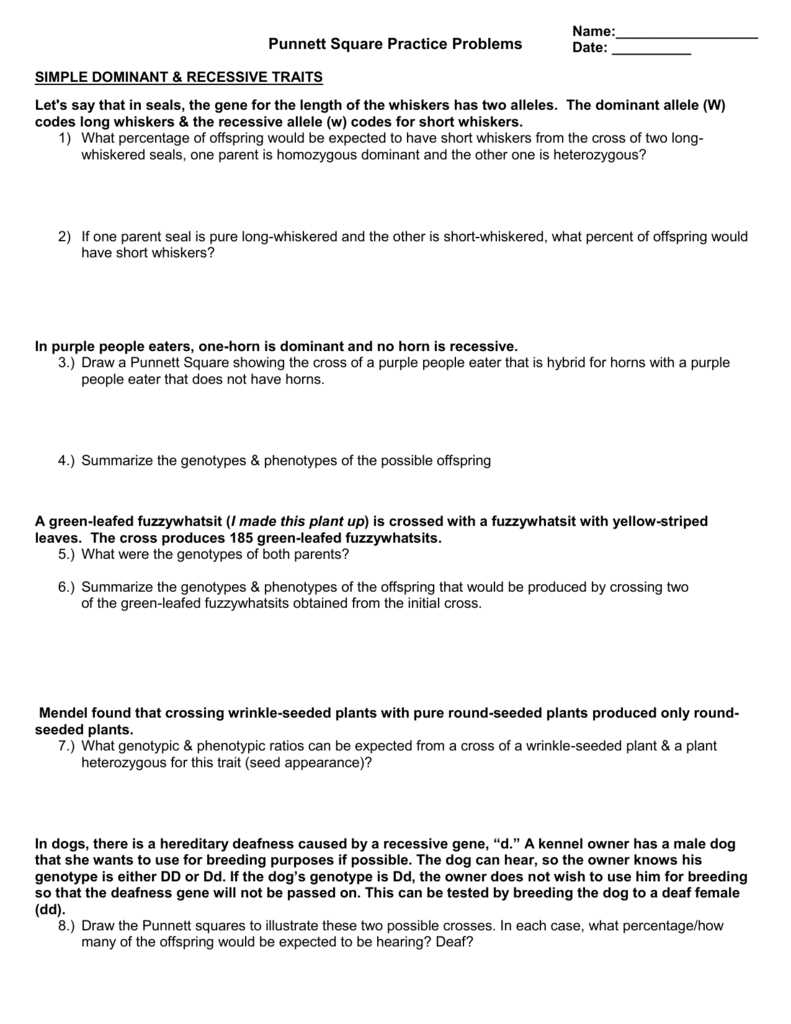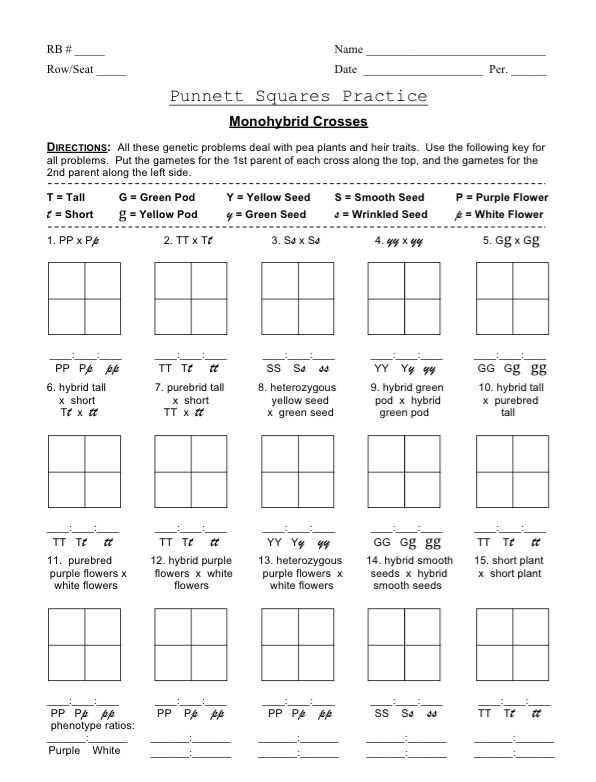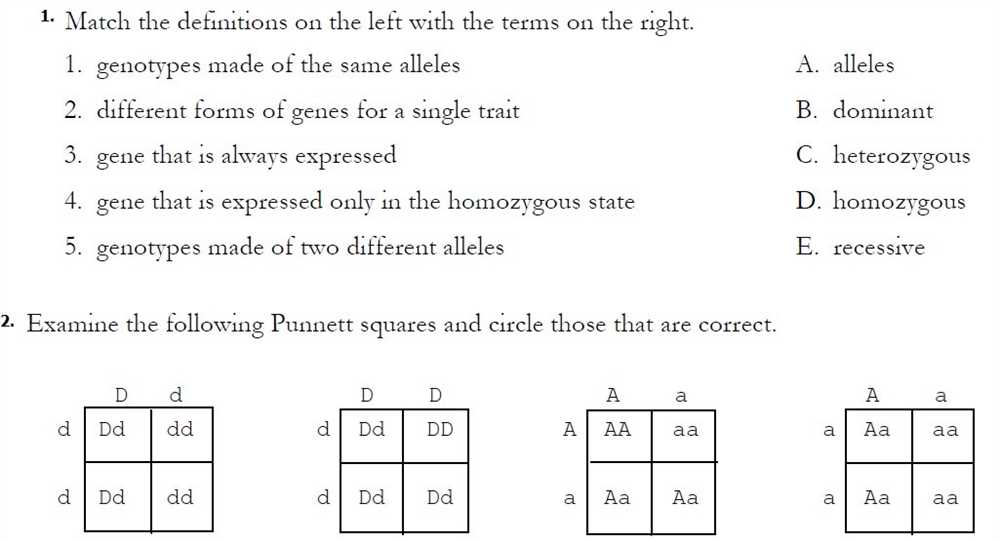
If you’re looking to enhance your understanding of Punnett squares, you’ve come to the right place. In this article, we will provide you with an answer key to help you practice and solidify your knowledge of Punnett square problems. By examining specific genetic traits and their probability of appearing in offspring, Punnett squares offer a visual representation of genetic inheritance patterns.
By using the answer key provided, you will be able to check your own work and identify any areas that may require further review. It’s a great way to reinforce your understanding and ensure you are mastering the concepts of Punnett squares. Whether you are a student studying genetics or someone with a general interest in the topic, this practice will help you strengthen your skills.
This answer key includes a variety of Punnett square problems, each with a different genetic scenario. From simple monohybrid crosses to more complex dihybrid crosses, you will have the opportunity to practice applying the rules of Mendelian genetics. By solving these problems and checking your answers, you will gain confidence in your ability to predict the likelihood of certain genetic traits in offspring.
So, grab a pen and paper, use the answer key as a guide, and get ready to sharpen your Punnett square skills. By completing these practice problems, you will be better equipped to understand the fundamentals of Punnett squares and genetic inheritance. Let’s get started!
Understanding Punnett Squares

Punnett squares are a powerful tool in genetics that help us understand how traits are inherited from one generation to the next. They provide a visual representation of the possible combinations of alleles that can be passed on from parents to offspring. By understanding Punnett squares, we can predict the probability of certain traits appearing in future generations.
In a Punnett square, the alleles of both parents are represented along the top and side of the square. Each box within the square represents a possible combination of alleles that can be passed on to the offspring. The capital letter represents the dominant allele, while the lowercase letter represents the recessive allele.
For example, let’s consider a Punnett square for eye color, where brown eyes are dominant (B) and blue eyes are recessive (b). If one parent has brown eyes (Bb) and the other parent has blue eyes (bb), the Punnett square would show that there is a 50% chance of the offspring having brown eyes (Bb) and a 50% chance of having blue eyes (bb).
Punnett squares are not only useful for predicting the outcome of a single trait, but they can also be used to predict the outcome of multiple traits. By using multiple Punnett squares, we can determine the probability of certain combinations of traits appearing in the offspring.
Learning the Basics of Punnett Squares
When studying genetics, one important concept that students learn about is Punnett squares. Punnett squares are used to predict the possible outcomes of genetic crosses by combining the alleles of two parents. Understanding how to use Punnett squares is essential in order to analyze inheritance patterns and predict the likelihood of certain traits being expressed in offspring.
Punnett squares are structured grids that allow geneticists to visualize the possible combinations of alleles that can be inherited from the parents. Each parent’s alleles are placed along the top and left side of the grid, and the boxes in the middle represent the possible combinations of alleles for the offspring. By filling in the boxes with the appropriate alleles, students can determine the genotypes and phenotypes of the offspring.
Using Punnett squares:
- Start by identifying the alleles each parent has for a specific trait.
- Write these alleles on the top and left side of the Punnett square grid.
- Fill in the boxes of the grid by combining the alleles from the parents.
- Determine the genotypes and phenotypes of the offspring by analyzing the combinations in the boxes.
Through practicing with Punnett squares, students can gain a better understanding of inheritance patterns and how different alleles interact with each other. This knowledge is vital in fields such as medicine and agriculture, where understanding the likelihood of certain traits being passed on is important for making informed decisions.
How Punnett Squares Help Predict Genetic Traits
Understanding genetic traits and how they are passed down from one generation to another is a fundamental aspect of genetics. Punnett squares are a valuable tool used by scientists to predict the likelihood of certain genetic traits in offspring.
In a Punnett square, the alleles of both parents are represented along the top and left side of a grid. Each allele is then combined to determine the possible genotypes of the offspring. By analyzing the possible combinations, scientists can make predictions about the phenotypes, or observable traits, of the offspring.
- Simple Punnett Squares: Punnett squares are commonly used to understand basic inheritance patterns, such as dominant and recessive traits. For example, if a dominant allele for brown fur (B) is crossed with a recessive allele for white fur (b), a Punnett square can be used to determine the probability of offspring having brown or white fur.
- Multifactorial Traits: Punnett squares can also be used to analyze more complex genetics, such as traits controlled by multiple genes. This involves considering multiple alleles and their potential combinations. By analyzing the different combinations, scientists can make predictions about the likelihood of certain traits appearing in offspring.
- Helpful in Genetic Counseling: Punnett squares are not only used in scientific research, but they are also valuable in genetic counseling. Genetic counselors can use Punnett squares to predict the likelihood of certain genetic disorders or traits in potential offspring. This information can help individuals make informed decisions about starting a family and understand the risks associated with certain genetic conditions.
Overall, Punnett squares are a powerful tool in genetics that allow scientists and genetic counselors to make predictions about the likelihood of certain traits appearing in offspring. By understanding inheritance patterns and analyzing allele combinations, Punnett squares help unravel the complex world of genetic traits.
Exploring More Punnett Square Practice Problems
In genetics, Punnett square practice problems are a common tool used to understand how traits are inherited and passed down from parents to offspring. By using Punnett squares, scientists and students can predict the probability of specific traits appearing in future generations.
One example of a Punnett square problem might involve determining the likelihood of a child inheriting certain physical characteristics from their parents. For instance, if a child has a mother with blonde hair (heterozygous) and a father with brown hair (homozygous), what is the probability of the child having either blonde or brown hair?
To solve this problem, we can use a Punnett square. The mother’s genotype would be represented as Bb (where B represents the dominant allele for brown hair and b represents the recessive allele for blonde hair), while the father’s genotype would be represented as BB. By crossing these genotypes in a Punnett square, we can determine that there is a 50% chance the child will have blonde hair (bb) and a 50% chance they will have brown hair (Bb).
Another example of a Punnett square problem might involve determining the likelihood of a child inheriting a certain disease or disorder. Let’s say both parents are carriers for a recessive genetic disorder, which means they each carry one copy of the mutated gene but do not show symptoms. What is the probability that their child will have the disorder?
To solve this problem, we can again use a Punnett square. Let’s say the disorder is represented by the letter D, with the normal gene represented by d. Both parents would have the genotypes Dd. By crossing these genotypes in a Punnett square, we can determine that there is a 25% chance the child will have the disorder (DD), a 50% chance they will be a carrier like their parents (Dd), and a 25% chance they will have the normal gene (dd).
Overall, Punnett squares provide a visual representation of genetic probabilities and can be a helpful tool in understanding how traits and disorders are inherited. By practicing more Punnett square problems, the concepts of genetics can become clearer, allowing for a deeper understanding of how genes are passed down through generations.
Reviewing Punnett Square Crosses for Monohybrid Traits

When studying genetics, one important concept to understand is how traits are inherited from parents to offspring. Punnett squares are a useful tool for visualizing and predicting the possible combinations of traits that can occur in offspring. In particular, monohybrid crosses involve the examination of a single trait.
In a monohybrid cross, two individuals that are heterozygous for the trait in question are bred together. Each parent can pass on either the dominant or recessive allele to their offspring, resulting in four possible combinations. By using Punnett squares, these combinations can be easily calculated and predicted.
Keyphrases:
- Punnett Square Crosses – Punnett squares are a visual tool used to predict trait combinations in offspring.
- Monohybrid Traits – Monohybrid crosses involve the examination of a single trait inheritance.
- Inherited Traits – Traits are passed down from parents to offspring through the transmission of alleles.
- Heterozygous Individuals – In a monohybrid cross, both parents are heterozygous for the trait in question.
- Dominant and Recessive Alleles – Offspring can inherit either the dominant or recessive allele from each parent.
By understanding the principles behind Punnett squares and monohybrid crosses, scientists and researchers can gain insights into how traits are inherited and the likelihood of certain traits appearing in future generations. This knowledge has important implications in areas such as agriculture and medicine, where understanding and manipulating genetic traits can have significant benefits.
Overall, regularly practicing Punnett square crosses for monohybrid traits helps reinforce these concepts and allows for a better understanding of inheritance patterns. Whether it’s determining the probability of eye color in humans or coat color in animals, Punnett squares remain a valuable tool in the study of genetics.
Practicing Punnett Squares for Dihybrid Crosses
The concept of dihybrid crosses is an important aspect of genetics that helps scientists predict the probability of certain traits appearing in offspring. By using Punnett squares, we can visually represent the combinations of alleles that can be inherited from two different genes. This practice is essential in understanding how traits are inherited and can be used to make predictions about future generations.
When practicing Punnett squares for dihybrid crosses, it is important to remember that each gene has two alleles, one inherited from each parent. These alleles can be either dominant or recessive, and their combination determines the traits that will be expressed in the offspring. By crossing two individuals with known genotypes, we can determine the probability of specific phenotypic traits appearing in their offspring.
- To begin, draw a 4×4 square, with each side representing the possible alleles from each parent for the two genes being crossed.
- Label the squares along the top and side with the alleles from one parent, and fill in the squares with the possible combinations of alleles.
- Once the Punnett square is complete, analyze the results by determining the genotypes and corresponding phenotypes of the potential offspring.
- Use the information gathered from the Punnett square to calculate the probability of certain traits appearing in the offspring.
By practicing Punnett squares for dihybrid crosses, individuals can further develop their understanding of Mendelian genetics and the laws of inheritance. This skill is valuable in various fields, including agriculture, medicine, and evolutionary biology, as it allows scientists to make informed predictions about genetic outcomes and better understand the complexities of inheritance.
Analyzing Punnett Square Practice 11-2: Answer Key
The Punnett Square Practice 11-2 Answer Key provides a comprehensive analysis of the potential outcomes of genetic crosses. By referring to this answer key, students can assess their understanding of Punnett square calculations and predict the phenotypic and genotypic ratios that may result from specific combinations of parental alleles.
One of the main purposes of Punnett Square Practice 11-2 is to reinforce the concept of dominant and recessive traits. By completing the Punnett squares and referring to the answer key, students can identify which alleles are dominant and which are recessive. This understanding is crucial in predicting the inheritance patterns of traits in future genetic crosses.
The answer key also helps students identify any errors they may have made in their Punnett square calculations. By comparing their own results with the answer key, students can identify any discrepancies and understand where they went wrong. This feedback is crucial in reinforcing the correct methods of completing Punnett squares and understanding the principles of Mendelian genetics.
In addition to providing the correct answers, the answer key also explains the reasoning behind each outcome. This helps students understand the logic and principles behind Punnett square calculations. By understanding the underlying concepts, students can apply this knowledge to more complex genetic scenarios and develop a deeper understanding of inheritance patterns.
Overall, the Punnett Square Practice 11-2 Answer Key is a valuable tool for students to assess their knowledge and understanding of Punnett square calculations. By using this answer key, students can identify any mistakes, reinforce their understanding of dominant and recessive traits, and develop a deeper understanding of genetics principles.